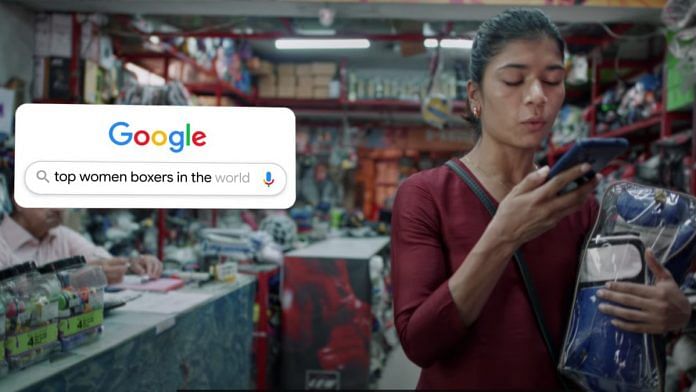How do you advertise something that needs no advertising at all? Ask Google. We go to ‘Google baba’ with the most lukewarm queries, most burning questions, and look for the coolest outfits. So, does such a simple, integral everyday task really need advertising to attract us to the search engine?
Google finds potential in generating awareness about their voice assistant. Google India’s campaign #BolneSeSabHoga, which generates awareness about Google’s voice search feature is a cool yet very warm campaign.
The latest films feature only women, and are part-testimonial ads that are snappy and don’t have a single boring moment. A series of four films tell the audience how Google helped Prachi Shevgaonkar (Founder, Cool the Globe app), Sriya Lenka (Indian K-Pop star), Kiran Dembla (bodybuilding champion) and Nikhat Zareen (boxing champion), achieve their dreams on their own mettle, when the world was doing nothing but bringing them down.
The writing is great, it follows the same style in all ads but never gets old or boring. The Nikhat Zareen one is particularly good. “Logo ne kaha boxing is not meant for girls (people said boxing is not for girls),” opens Zareen’s testimonial, “maine kaha (to her phone) ‘top women boxers in the world.”
And the ad goes on like that, people cast aspersions on the woman’s dreams, and Zareen finds support for them in Google.
The films have been conceptualised by Toaster India, Google’s in-house agency, where the writers and art directors seem to be having a gala time, churning out commercials with intricate story-telling. The credits for ads are difficult to find, but the writers of this campaign deserve the praise.
It’s not surprising that Google chose only female-driven stories for the testimonials. Currently, women in India use Google far more than men, making them the primary target audience. Women users in the age group of 35-44 outnumber men by 123 per cent while in the 15-24 age group, the number of minutes spent on Google increased 110 per cent from 2011 for women while it was 104 per cent for men.
But that doesn’t mean men aren’t on Google at all, and the absence of any other gender or age group is noticeable and not in a good way.
To be fair, the campaign has been going on for a while. Last year, a series of films starring Gajraj Rao as father of aspiring daughters took a more slice-of-life route in the films that celebrate tiny individual successes like getting into your dream college or getting a cover-page story idea just by a simple Google search.
Before the campaign got its current name #BolneSeSabHoga, the first set of ad films featured everyday people like an auto driver, a sweet shop owner etc. Those films were more rooted in Google’s everyday functioning, and were instances we usually tend to look up to.
Through this campaign, Google reminds us of just how easy the search engine has made our lives and the impact it creates. Googling is something we take for granted, and the campaign brings out the beauty of a banal verb. Only great writing can achieve such a feat so competently.
The way newer and newer films take this campaign forward is very refreshing and one can’t help but wait to see the next leg of the voice search ad series.
Also read: Vicco Vajradanti ad starring Alia Bhatt is a cringe follow-up to an era-defining jingle
Voice search push
But why is Google focussing on promoting voice search and assistant-use so much?
Google finds out that most Indians – 72 per cent to be precise – prefer Googling in their native language and not English, with voice assistant search leading the way. Google says voice search is currently driving growth — 60 per cent smartphone users interact with their phone using voice.
“This trend of using voice technology is not simply confined to assistants or smart devices in the home; it’s also shaping the way Indians interact with their smartphones. Voice is emerging as the preferred way for people to use Search and browse YouTube,” Google writes.
Google also finds people are much more interactive while searching using voice command than when they type out. “Not only are people asking detailed questions, but because the majority of Indians are multilingual, they find voice three times faster than typing. During the 2019 cricket season, Google Assistant received over 100 million cricket queries as people asked for news and live score updates,” the company writes on its blog.
(Edited by Anurag Chaubey)



